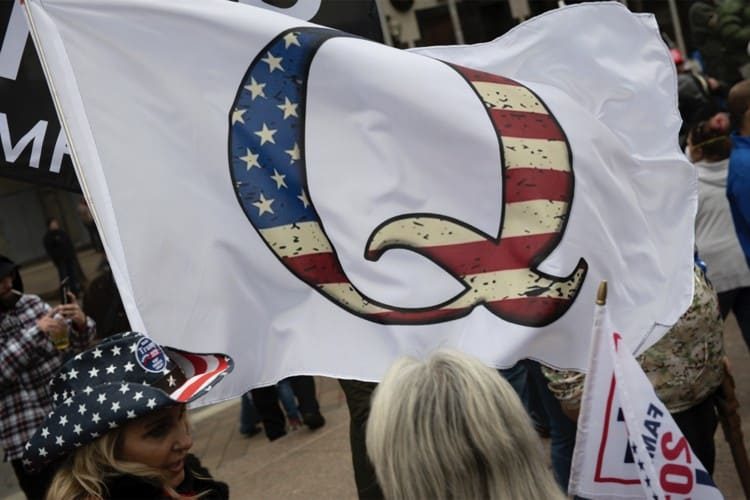
It appears as if “Q” has been unmasked. According to two teams of Swiss and French researchers working independently, Q was actually two men — neither of whom had any inside information. That would make Q, who supposedly was a government insider, a complete and utter fraud, which is what The New American has said all along (see here and here) based on Q’s false predictions.
While the identity of Q had managed to remain anonymous (thus often being referred to as QAnon) since the first “drop” in October 2017, many speculated as to who Q may be. The speculation ran the full range, with some even imagining that Q was President Trump. But, according to two independent groups of computer scientists who independently used different approaches and machine learning software to analyze Q’s roughly 5,000 drops, Q was two men: Paul Furber, a South African software developer; and Arizona congressional candidate Ron Watkins.
According to those researchers, Furber — who first drew attention to Q — was the first to write under the pseudonym, though Watkins occasionally shared in that role. Then, after Q switched over to Watkins’ father’s 8chan message board, Watkins took over, becoming the only person posting as Q.
As Engadget — a website that reports on technology and tech trends — reports:
The two teams of Swiss and French researchers used different methodologies to come to the same conclusion. The Swiss one, made up of two researchers from startup OrphAnalytics, used software to break down Q’s missives into patterns of three-character sequences. They then tracked how often those sequences repeated. The French team, meanwhile, trained an AI to look for patterns in Q’s writing. Both techniques broadly fall under an approach known as stylometry that looks to analyze writing in a way that is measurable, consistent and replicable. To avoid the possibility of confusing their respective programs, the teams limited their analysis to social media posts. Among all the other possible authors they put through the test, they say the writing of Furber and Watkins stood out the most for how similar it was that of Q’s.
And they’re confident in that identification. The French team made of computational linguists Florian Cafiero and Jean-Baptiste Camps told The Times their software correctly identified Furber’s writing in 98 percent of tests and Watkins’ in 99 percent. “At first most of the text is by Furber,” said Cafiero. “But the signature of Ron Watkins increased during the first few months as Paul Furber decreased and then dropped completely.”
Stylometry is an established scientific method used to identify unknown or anonymous writers. The basic premise is that a writer tends to use the same word order and phrasing, no matter what he is writing and software can analyze anonymous writings to identify the writer by comparing the anonymous work to other available writings known to be from that writer.
This writer has somewhere in the neighborhood of 1,500 articles published online and in print. Add to that the decade or so of social media posts before I ditched social media, and a simple machine learning software analysis of an “anonymous” post I write would very quickly identify me as the author. Even if I tried to complicate matters by avoiding some of my trademark phrasing — such as “to put in the for-what-it’s-worth-column” and “let’s spend a few minutes unpacking that” — and even if I laid off the use of em dashes to mark out parenthetical statements, the software would identify word frequency, word order, and other traits that are marks of my writing.
And this writer is not alone in that. As Engadget pointed out in the above-cited article, when the crime novel Cuckoo’s Calling was published in 2013 under the name Robert Galbraith, machine learning software was used to identify Harry Potter author J.K. Rowling as the actual author. The same method has been used by law enforcement in countless cases and was famously used to identify the Unabomber as Theodore Kaczynski.
So, with the French team able to identify “Furber’s writing in 98 percent of tests and Watkins’ in 99 percent,” those teams are “confident in [their] identification” of Furber and Watkins as Q. And while speculations ran wild as various online sleuths — including both Q followers and Q detractors — have tried to solve the mystery of the identity of Q over the past more-than-three-years, Furber was “increasingly overlooked,” according to the New York Times, which broke the story.
However, it is important to note that while the Times broke the story by being the first to report on it, it was not the Times that conducted the research that appears to have unmasked Q. Again, that credit belongs to two groups of linguists and computer scientists who — working independently from each other — arrived at the same conclusion.
According to these researchers, Q is not Trump or anyone associated with the Trump administration. In fact, if they are correct, Q was not (as claimed) a “top military insider” with secret knowledge of the inner workings of Trump’s epic battle against pedophile satanists within the U.S. government. If the researchers are correct, Q was two trolls using the Internet to do what trolls do.
Both Furber and Watkins have stated they are not Q. According to Furber, the similarity between Q’s writings and his own were due to his emulation of Q, reported the Times. Furber also said that Q’s messages “took over our lives, literally,” and that “we all started talking like him.” According to the Times report, two prominent experts in the type of linguistic research that went into the machine learning that appears to have unmasked Furber and Watkins “said that was implausible, and the scientists who conducted the studies noted that their analyses included tweets by Mr. Furber from the first days Q emerged.”
Watkins has stated of Q’s posts, “There is probably more good stuff than bad.” But as this writer has taken pains to point out in previous articles, that is simply not so. For with nearly 5,000 cryptic posts spanning just over three years — between October 28, 2017 and December 8, 2020 — Q drops ran the full range from the incredible to the ridiculous and they were all false. Not one thing Q predicted ever came to pass. And even the claims of things that were supposedly taking place in the present were bogus.
But even with all of that, some true believers have held on for dear life, with a faith that mirrors religious conviction.
Because as the Times reported:
The studies provide the first empirical evidence of who invented the toxic QAnon myth, and the scientists who conducted the studies said they hoped that unmasking the creators might weaken its hold over QAnon followers. Some polls indicate that millions of people still believe that Q is a top military insider whose messages have revealed that former President Trump will save the world from a cabal of “deep state” Democratic pedophiles.
This writer and this magazine have both experienced the die-hard “faith” of some of some of the true believers in the QAnon cult — as a brief perusal of previously published articles and videos exposing Q as a fraud will show. In one of those articles, this writer compared Q’s faithful to those who experienced the Great Disappointment.
As that article explained:
In the 1800’s, Baptist preacher William Miller predicted the Second Coming of Christ would happen on October 22, 1844. Those who followed Miller — called “Millerites” — had all but quit this world. Many had neglected their businesses and farms, running up debts in the process. But none of that would matter because the Lord would return and take them to Heaven. When October 22 came and the Lord did not, they waited with great anticipation — it would happen any minute now. But it never did.
And:
While most Millerites did their best to pick up what was left of their lives and get on with the business of living by leaving Miller and his predictions alone for the rest of their lives, others started their own spin-off religious movements, claiming that Miller was essentially right, but that the event was spiritual, rather than material.
Likewise, many Q followers are still hanging on for dear life to the false hope that Q administered to them in small, regular doses.
And while “the scientists who conducted the studies” are hopeful that “unmasking the creators might weaken its hold over QAnon followers,” they likely overlook the power of faith and hope — even misplaced faith and false hope. But this writer shares the hope of those researchers that at least some of the hangers on will finally see the light of day and let Q go.


